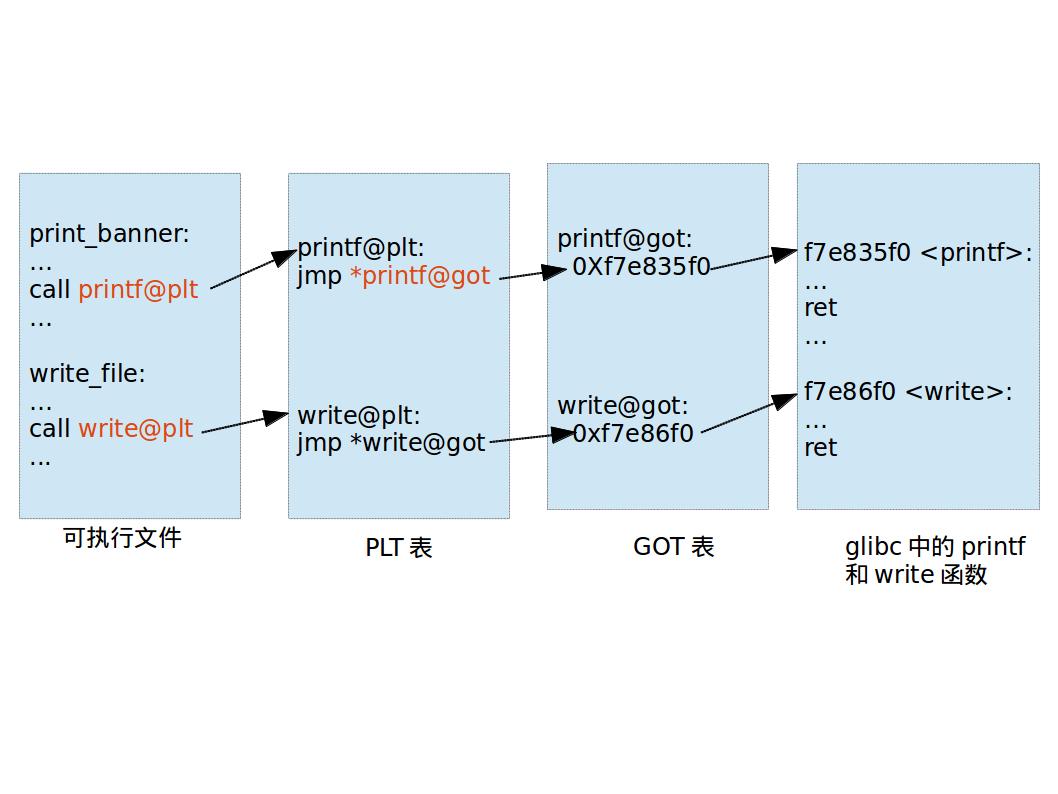深入理解plt和got
先写一段代码:
1 | // Build with: gcc -m32 --no-pie -g -o plt plt.c |
途中遇到了一个报错:1
2
3
4In file included from /usr/include/stdio.h:27:0,
from plt.c:3:
/usr/include/features.h:374:25: fatal error: sys/cdefs.h: No such file or directory
# include <sys/cdefs.h>
然后安装一个:apt install libc6-dev-i386
编译好程序之后
1 | $ checksec plt |
程序是没有pie的
readelf -S plt查看节表
1 | [Nr] Name Type Addr Off Size ES Flg Lk Inf Al |
可以看到:
- .plt 基地址为:
0x08048300 - .got 基地址为:
0x08049ffc - .got.plt 基地址为:
0x0x804a000
我们从调用puts函数那里开始单步执行
首先跳转到plt表中1
20x804845d <main+16> call puts@plt <0x8048310>
0x8048310 <puts@plt> jmp dword ptr [puts@got.plt] <0x804a00c>
call puts之后,下一条指令也是一个跳转
jmp dword ptr [puts@got.plt] <0x804a00c>
这条指令的意思是取出puts@got.plt表中的值,放到pc寄存器中
所以?查看一下此处内存的值:
1 | pwndbg> x/2x 0x804a00c |
所以下一条指令的地址就是0x08048316还是在plt表中
1 | ► 0x8048316 <puts@plt+6> push 0 |
这里先将0放到栈上,表明是要解析puts函数的地址,然后再跳转到0x8048300也就是plt表的开始部分
1 | ► 0x8048300 push dword ptr [_GLOBAL_OFFSET_TABLE_+4] <0x804a004> |
这时候先把.got.plt表中的第二项放到栈上
先查看一下.got.plt中前三项的内容:
1 | pwndbg> x/3x 0x804a000 |
将0xf7ffd938放置到栈上,然后跳转到.got.plt中的第三项,也就是0xf7ff0650,这个地址就是_dl_runtime_resolve函数的地址
负责解析函数的地址
此时我们的got表内容如下:
1 | pwndbg> got |
puts函数的地址还没有重定位
当我们执行过一遍puts函数之后
这时候回过头来继续查看got表中的内容:
1 | pwndbg> got |
可以看到地址已经重定位好了
这和Windows的PE文件格式似乎有点不同了,PE文件是装载进内存之后函数地址都已经重定位好了,而Linux的elf文件刚刚装进内存之后函数的地址还是不确定的,需要在运行的时候进行重定位。
当我们将代码修改为如下时:
1 | pwndbg> l 1, 20 |
第一次调用puts函数之后:[0x804a00c] puts -> 0xf7e727e0 (puts) ◂— push ebp
puts函数地址已经重定位好了
接下来再次调用puts函数
1 | ► 0x8048310 <puts@plt> jmp dword ptr [0x804a00c] <0xf7e727e0> |
此时可以看到直接就跳到函数的地址了
因为此时的.got.plt已经是puts函数的地址了, Linux tql
整理一下
之前看参考资料中博主的文章一直没有很理解,这里直接统一说一下我的理解:
何谓PLT与GOT
其实这里准确的来说应该叫got.plt而不是叫got,不过为了方便我们还是叫它got表吧

要注意那个jmp *printf@got *号是取出地址处的值,并不是跳到got表中去
延迟重定位
这篇文章我觉得写的很精彩
Linux为了缩减代码,就是按照这种模式来的:
1 | void printf@plt() |
也就和上面那张图是一一对应的
公共got表项
在解析函数的真正地址时, _dl_runtime_resolve是怎么知道它要解析哪个函数的
因为:
1 | printf@plt>: |
这里push的值不一样,相当于就是每个函数取了一个id
之后就是公共got表的内容:
- got[0]: 本ELF动态段(.dynamic段)的装载地址
- got[1]:本ELF的link_map数据结构描述符地址
- got[2]:_dl_runtime_resolve函数的地址
穿针引线
PLT表中的第一项为公共表项,剩下的是每个动态库函数为一项(当然每项是由多条指令组成的,jmp *0xXXXXXXXX这条指令是所有plt的开始指令)每项PLT都从对应的GOT表项中读取目标函数地址
GOT表中前3个为特殊项,分别用于保存 .dynamic段地址、本镜像的link_map数据结构地址和_dl_runtime_resolve函数地址;但在编译时,无法获取知道link_map地址和_dl_runtime_resolve函数地址,所以编译时填零地址,进程启动时由动态链接器进行填充
参考
聊聊Linux动态链接中的PLT和GOT(1)——何谓PLT与GOT
聊聊Linux动态链接中的PLT和GOT(2)——延迟重定位
聊聊Linux动态链接中的PLT和GOT(3)——公共GOT表项
聊聊Linux动态链接中的PLT和GOT(4)—— 穿针引线
GOT and PLT for pwning.
